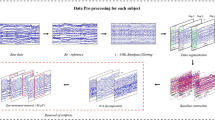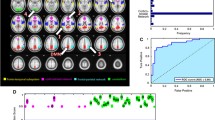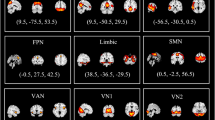Abstract
Tourette syndrome (TS) is a childhood-onset neurological disorder. To date, accurate TS diagnosis remains challenging due to its varied clinical expressions and dependency on qualitative description of symptoms. Therefore, identifying accurate and objective neuroimaging biomarkers may help improve early TS diagnosis. As resting-state functional MRI (rs-fMRI) has been demonstrated as a promising neuroimaging tool for TS diagnosis, previous rs-fMRI studies on TS revealed functional connectivity (FC) changes in a few local brain networks or circuits. However, no study explored the disrupted topological organization of whole-brain FC networks in TS children. Meanwhile, very few studies have examined brain functional networks using machine-learning methods for diagnostics. In this study, we construct individual whole-brain, ROI-level FC networks for 29 drug-naive TS children and 37 healthy children. Then, we use graph theory analysis to investigate the topological disruptions between groups. The identified disrupted regions in FC networks not only involved the sensorimotor association regions but also the visual, default-mode and language areas, all highly related to TS. Furthermore, we propose a novel classification framework based on similarity network fusion (SNF) algorithm, to both diagnose an individual subject and explore the discriminative power of FC network topological properties in distinguishing between TS children and controls. We achieved a high accuracy of 88.79%, and the involved discriminative regions for classification were also highly related to TS. Together, both the disrupted topological properties between groups and the discriminative topological features for classification may be considered as comprehensive and helpful neuroimaging biomarkers for assisting the clinical TS diagnosis.








Similar content being viewed by others
Abbreviations
- TS:
-
Tourette syndrome
- rs-fMRI:
-
Resting-state functional magnetic resonance imaging
- FC:
-
Functional connectivity
- DTI:
-
Fiffusion tensor imaging
- WM:
-
White matter
- YGTSS:
-
Yale Global Tic Severity Scale
- SNF:
-
Similarity network fusion
References
Lombroso PJ, Scahill L (2008) Tourette syndrome and obsessive–compulsive disorder. Brain Dev 30(4):231–237
Stokes A, Bawden HN, Camfield PR, Backman JE, Dooley JM (1991) Peer problems in Tourette’s disorder. Pediatrics 87(6):936–942
Cavanna AE, Servo S, Monaco F, Robertson MM (2009) The behavioral spectrum of Gilles de la Tourette syndrome. The Journal of neuropsychiatry and clinical neurosciences 21(1):13–23. doi:10.1176/appi.neuropsych.21.1.13
Scharf JM, Miller LL, Gauvin CA, Alabiso J, Mathews CA, Ben-Shlomo Y (2015) Population prevalence of Tourette syndrome: a systematic review and meta-analysis. Movement disorders : official journal of the Movement Disorder Society 30(2):221–228. doi:10.1002/mds.26089
Cavanna AE, Seri S (2013) Tourette’s syndrome. BMJ 347(2):67–71
Cui Y, Jin Z, Chen X, He Y, Liang X, Zheng Y (2014) Abnormal baseline brain activity in drug-naive patients with Tourette syndrome: a resting-state fMRI study. Front Hum Neurosci 7:913. doi:10.3389/fnhum.2013.00913
Ganos C, Kahl U, Brandt V, Schunke O, Bäumer T, Thomalla G, Roessner V, Haggard P et al (2014) The neural correlates of tic inhibition in Gilles de la Tourette syndrome. Neuropsychologia 65(1624):297–301
Greene DJ, Schlaggar BL, Black KJ (2015) Neuroimaging in Tourette syndrome: research highlights from 2014 to 2015. Current developmental disorders reports 2(4):300–308
Church JA, Fair DA, Dosenbach NU, Cohen AL, Miezin FM, Petersen SE, Schlaggar BL (2009) Control networks in paediatric Tourette syndrome show immature and anomalous patterns of functional connectivity. Brain 132(Pt 1):225–238. doi:10.1093/brain/awn223
Werner CJ, Stocker T, Kellermann T, Wegener HP, Schneider F, Shah NJ, Neuner I (2010) Altered amygdala functional connectivity in adult Tourette’s syndrome. Eur Arch Psychiatry Clin Neurosci 260(Suppl 2):S95–S99. doi:10.1007/s00406-010-0161-7
Worbe Y, Malherbe C, Hartmann A, Pelegrini-Issac M, Messe A, Vidailhet M, Lehericy S, Benali H (2012) Functional immaturity of cortico-basal ganglia networks in Gilles de la Tourette syndrome. Brain 135(Pt 6):1937–1946. doi:10.1093/brain/aws056
Watts DJ, Strogatz SH (1998) Collective dynamics of ’small-world’ networks. Nature 393(6684):440–442
Salvador R, Suckling J, Coleman MR, Pickard JD, Menon D, Bullmore E (2005) Neurophysiological architecture of functional magnetic resonance images of human brain. Cereb Cortex 15(9):1332–1342. doi:10.1093/cercor/bhi016
Wang J, Li T, Wang N, Xian J, He H (2016) Graph theoretical analysis reveals the reorganization of the brain network pattern in primary open angle glaucoma patients. Eur Radiol. doi:10.1007/s00330-016-4221-x
Cerasa A, Castiglioni I, Salvatore C, Funaro A, Martino I, Alfano S, Donzuso G, Perrotta P et al (2015) Biomarkers of eating disorders using support vector machine analysis of structural neuroimaging data: preliminary results. Behav Neurol 51(1):50–62
Liu F, Wee CY, Chen H, Shen D (2014) Inter-modality relationship constrained multi-modality multi-task feature selection for Alzheimer’s disease and mild cognitive impairment identification. NeuroImage 84:466–475. doi:10.1016/j.neuroimage.2013.09.015
Chi M, Guo S, Ning Y, Li J, Qi H, Gao M, Wang J, Hu X et al (2014) Using support vector machine to identify imaging biomarkers of major depressive disorder and anxious depression. Springer, Berlin Heidelberg
Dai D, Wang J, Hua J, He H (2012) Classification of ADHD children through multimodal magnetic resonance imaging. Front Syst Neurosci 6:63–63
Dai D, He H, Vogelstein JT, Hou Z (2013) Accurate prediction of AD patients using cortical thickness networks. Machine Vision & Applications 24(7):1445–1457
Jie B, Zhang D, Gao W, Wang Q, Wee CY, Shen D (2014) Integration of network topological and connectivity properties for neuroimaging classification. IEEE Trans Biomed Eng 61(2):576–589. doi:10.1109/TBME.2013.2284195
Jin Y, Wee CY, Shi F, Thung KH, Ni D, Yap PT, Shen D (2015) Identification of infants at high-risk for autism spectrum disorder using multiparameter multiscale white matter connectivity networks. Human brain mapping
Sacchet MD, Prasad G, Folandross LC, Thompson PM, Gotlib IH (2015) Support vector machine classification of major depressive disorder using diffusion-weighted neuroimaging and graph theory. Frontiers in psychiatry 6:21
Greene DJ, Church JA, Dosenbach NUF, Nielsen AN, Adeyemo B, Nardos B, Petersen SE, Black KJ et al (2016) Multivariate pattern classification of pediatric Tourette syndrome using functional connectivity MRI. Dev Sci
Liao W, Yu Y, Miao H-H, Feng Y-X, Ji G-J, Feng J-H (2016) Inter-hemispheric intrinsic connectivity as a neuromarker for the diagnosis of boys with Tourette syndrome. Mol Neurobiol 1–9
Wen H, Liu Y, Wang J, Zhang J, Peng Y, He H (2016) A diagnosis model for early Tourette syndrome children based on brain structural network characteristics. In: SPIE Medical Imaging. International Society for Optics and Photonics, p 97852R-97852R-97859
Golden GS (1977) The effect of central nervous system stimulants on Tourette syndrome. Ann Neurol 2(1):69–70
Scahill L, Riddle MA, McSwiggin-Hardin M, Ort SI, King RA, Goodman WK, Cicchetti D, Leckman JF (1997) Children’s Yale-Brown obsessive compulsive scale: reliability and validity. J Am Acad Child Adolesc Psychiatry 36(6):844–852. doi:10.1097/00004583-199706000-00023
Retz-Junginger P, Retz W, Blocher D, Stieglitz RD, Georg T, Supprian T, Wender PH, Rosler M (2003) Reliability and validity of the Wender-Utah-Rating-Scale short form. Retrospective assessment of symptoms for attention deficit/hyperactivity disorder. Nervenarzt 74(11):987–993. doi:10.1007/s00115-002-1447-4
Leckman JF, Riddle MA, Hardin MT, Ort SI, Swartz KL, Stevenson J, Cohen DJ (1989) The Yale Global Tic Severity Scale: initial testing of a clinician-rated scale of tic severity. J Am Acad Child Adolesc Psychiatry 28(4):566–573. doi:10.1097/00004583-198907000-00015
Tzourio-Mazoyer N, Landeau B, Papathanassiou D, Crivello F, Etard O, Delcroix N, Mazoyer B, Joliot M (2002) Automated anatomical labeling of activations in SPM using a macroscopic anatomical parcellation of the MNI MRI single-subject brain. NeuroImage 15(1):273–289
Cao Q, Shu N, An L, Wang P, Sun L, Xia MR, Wang JH, Gong GL et al (2013) Probabilistic diffusion tractography and graph theory analysis reveal abnormal white matter structural connectivity networks in drug-naive boys with attention deficit/hyperactivity disorder. J Neurosci 33(26):10676–10687. doi:10.1523/JNEUROSCI.4793-12.2013
Wang J, Zuo X, He Y (2010) Graph-based network analysis of resting-state functional MRI. Front Syst Neurosci 4:16. doi:10.3389/fnsys.2010.00016
He Y, Dagher A, Chen Z, Charil A, Zijdenbos A, Worsley K, Evans A (2009) Impaired small-world efficiency in structural cortical networks in multiple sclerosis associated with white matter lesion load. Brain 132(Pt 12):3366–3379. doi:10.1093/brain/awp089
Zhang J, Wang J, Wu Q, Kuang W, Huang X, He Y, Gong Q (2011) Disrupted brain connectivity networks in drug-naive, first-episode major depressive disorder. Biol Psychiatry 70(4):334–342. doi:10.1016/j.biopsych.2011.05.018
Zhang D, Liu X, Chen J, Liu B, Wang J (2015) Widespread increase of functional connectivity in Parkinson’s disease with tremor: a resting-state FMRI study. Front Aging Neurosci 7:6. doi:10.3389/fnagi.2015.00006
Wang J, Wang X, Xia M, Liao X, Evans A, He Y (2015) GRETNA: a graph theoretical network analysis toolbox for imaging connectomics. Front Hum Neurosci 9:386. doi:10.3389/fnhum.2015.00386
Wang B, Mezlini AM, Demir F, Fiume M, Tu Z, Brudno M, Haibe-Kains B, Goldenberg A (2014) Similarity network fusion for aggregating data types on a genomic scale. Nat Methods 11(3):333–337. doi:10.1038/nmeth.2810
Guyon I, Weston J, Barnhill S, Vapnik V (2002) Gene selection for cancer classification using support vector machines. Mach Learn 46(1–3):389–422. doi:10.1023/A:1012487302797
Wen H, Liu Y, Rekik I, Wang S, Chen Z, Zhang J, Zhang Y, Peng Y et al (2017) Multi-modal multiple kernel learning for accurate identification of Tourette syndrome children. Pattern Recogn 63:601–611
Wilson SM, Ogar JM, Laluz V, Growdon M, Jang J, Glenn S, Miller BL, Weiner MW et al (2009) Automated MRI-based classification of primary progressive aphasia variants. NeuroImage 47(4):1558–1567. doi:10.1016/j.neuroimage.2009.05.085
Benjamini Y, Hochberg Y (2015) Controlling the false discovery rate—a practical and powerful approach to multiple testing. J R Stat Soc 57(57):289–300
Achard S, Salvador R, Whitcher B, Suckling J, Bullmore E (2006) A resilient, low-frequency, small-world human brain functional network with highly connected association cortical hubs. J Neurosci 26(1):63–72. doi:10.1523/JNEUROSCI.3874-05.2006
He Y, Chen ZJ, Evans AC (2007) Small-world anatomical networks in the human brain revealed by cortical thickness from MRI. Cereb Cortex 17(10):2407–2419. doi:10.1093/cercor/bhl149
Iturria-Medina Y, Sotero RC, Canales-Rodriguez EJ, Aleman-Gomez Y, Melie-Garcia L (2008) Studying the human brain anatomical network via diffusion-weighted MRI and graph theory. NeuroImage 40(3):1064–1076. doi:10.1016/j.neuroimage.2007.10.060
Gong G, He Y, Concha L, Lebel C, Gross DW, Evans AC, Beaulieu C (2009) Mapping anatomical connectivity patterns of human cerebral cortex using in vivo diffusion tensor imaging tractography. Cereb Cortex 19(3):524–536. doi:10.1093/cercor/bhn102
Liu T, Chen Y, Lin P, Wang J (2015) Small-world brain functional networks in children with attention-deficit/hyperactivity disorder revealed by EEG synchrony. Clinical EEG and neuroscience 46(3):183–191. doi:10.1177/1550059414523959
Wang L, Zhu C, He Y, Zang Y, Cao Q, Zhang H, Zhong Q, Wang Y (2009) Altered small-world brain functional networks in children with attention-deficit/hyperactivity disorder. Hum Brain Mapp 30(2):638–649. doi:10.1002/hbm.20530
Latora V, Marchiori M (2001) Efficient behavior of small-world networks. Phys Rev Lett 87(19):198701. doi:10.1103/PhysRevLett.87.198701
Liu Y, Miao W, Wang J, Gao P, Yin G, Zhang L, Lv C, Ji Z et al (2013) Structural abnormalities in early Tourette syndrome children: a combined voxel-based morphometry and tract-based spatial statistics study. PLoS One 8(9):e76105. doi:10.1371/journal.pone.0076105
Wen H, Liu Y, Wang J, Rekik I, Zhang J, Zhang Y, Tian H, Peng Y et al (2016) Combining tract- and atlas-based analysis reveals microstructural abnormalities in early Tourette syndrome children. Hum Brain Mapp 37(5):1903–1919. doi:10.1002/hbm.23146
Liu Y, Duan YY, He Y, Wang J, Xia MR, Yu CS, Dong HQ, Ye J et al (2012) Altered topological organization of white matter structural networks in patients with neuromyelitis optica. PLoS One 7(11):e48846. doi:10.1371/journal.pone.0048846
Sporns O, Honey CJ, Kotter R (2007) Identification and classification of hubs in brain networks. PLoS One 2(10):e1049. doi:10.1371/journal.pone.0001049
Wu J, Qian Z, Tao L, Ding S (2013) The comparison of orientation and methods of hubs in the resting state functional brain network. Journal of Biomedical Engineering Research 3:006
Tang Y, Long J, Wang W, Liao J, Xie H, Zhao G, Zhang H (2016) Aberrant functional brain connectome in people with antisocial personality disorder. Sci Rep 6:26209. doi:10.1038/srep26209
De Asis-Cruz J, Bouyssi-Kobar M, Evangelou I, Vezina G, Limperopoulos C (2015) Functional properties of resting state networks in healthy full-term newborns. Sci Rep 5:17755. doi:10.1038/srep17755
Yuan W, Wade SL, Babcock L (2015) Structural connectivity abnormality in children with acute mild traumatic brain injury using graph theoretical analysis. Hum Brain Mapp 36(2):779–792. doi:10.1002/hbm.22664
Worbe Y, Marrakchi-Kacem L, Lecomte S, Valabregue R, Poupon F, Guevara P, Tucholka A, Mangin JF et al (2015) Altered structural connectivity of cortico-striato-pallido-thalamic networks in Gilles de la Tourette syndrome. Brain 138(Pt 2):472–482. doi:10.1093/brain/awu311
Tinaz S, Belluscio BA, Malone P, Veen JWVD, Hallett M, Horovitz SG (2014) Role of the sensorimotor cortex in Tourette syndrome using multimodal imaging. Hum Brain Mapp 35(12):5834–5846
Ludolph AG, Juengling FD, Libal G, Ludolph AC, Fegert JM, Kassubek J (2006) Grey-matter abnormalities in boys with Tourette syndrome: Magnetic resonance imaging study using optimised voxel-based morphometry. The British journal of psychiatry : the journal of mental science 188:484–485. doi:10.1192/bjp.bp.105.008813
Worbe Y, Gerardin E, Hartmann A, Valabrégue R, Chupin M, Tremblay L, Vidailhet M, Colliot O et al (2010) Distinct structural changes underpin clinical phenotypes in patients with Gilles de la Tourette syndrome. Brain 133(Pt 12):3649–3660
Gates L, Clarke JA, Somorjai R, Jarmasz M, Vandorpe R, Dursun SM (2004) Neuroanatomy of coprolalia in Tourette syndrome using functional magnetic resonance imaging. Prog Neuro-Psychopharmacol Biol Psychiatry 28(2):397–400
Thomalla G, Jonas M, Baumer T, Siebner HR, Biermann-Ruben K, Ganos C, Orth M, Hummel FC et al (2014) Costs of control: Decreased motor cortex engagement during a Go/NoGo task in Tourette’s syndrome. Brain 137(Pt 1):122–136. doi:10.1093/brain/awt288
Buse J, Beste C, Herrmann E, Roessner V (2015) Neural correlates of altered sensorimotor gating in boys with Tourette Syndrome: a combined EMG/fMRI study. World J Biol Psychiatry 1–11. doi:10.3109/15622975.2015.1112033
Bohlhalter S, Goldfine A, Matteson S, Garraux G, Hanakawa T, Kansaku K, Wurzman R, Hallett M (2006) Neural correlates of tic generation in Tourette syndrome: an event-related functional MRI study. Brain 129(Pt 8):2029–2037. doi:10.1093/brain/awl050
Zapparoli L, Porta M, Paulesu E (2015) The anarchic brain in action: the contribution of task-based fMRI studies to the understanding of Gilles de la Tourette syndrome. Curr Opin Neurol 28(6):604–611. doi:10.1097/WCO.0000000000000261
Roessner V, Overlack S, Schmidt-Samoa C, Baudewig J, Dechent P, Rothenberger A, Helms G (2011) Increased putamen and callosal motor subregion in treatment-naive boys with Tourette syndrome indicates changes in the bihemispheric motor network. Journal of child psychology and psychiatry, and allied disciplines 52(3):306–314. doi:10.1111/j.1469-7610.2010.02324.x
Stern E, Silbersweig DA, Chee KY, Holmes A, Robertson MM, Trimble M, Frith CD, Frackowiak RS et al (2000) A functional neuroanatomy of tics in Tourette syndrome. Arch Gen Psychiatry 57(8):741–748
Felling RJ, Singer HS (2011) Neurobiology of tourette syndrome: current status and need for further investigation. Journal of Neuroscience the Official Journal of the Society for Neuroscience 31(35):12387–12395
Robertson MM (2000) Tourette syndrome, associated conditions and the complexities of treatment. Brain 123:425–462. doi:10.1093/brain/123.3.425
Acknowledgements
We thank Dr. Hao Huang at University of Pennsylvania for consultation and support on MR pulse sequences.
This work was supported by the National Natural Science Foundation of China (91520202, 61271151, 31271161, 81671651), Youth Innovation Promotion Association CAS and Beijing Municipal Administration of Hospitals Incubating Program (PX2016035), and Beijing Health System Top level Health Technical Personnel Training Plan (2015-3-082).
Author information
Authors and Affiliations
Corresponding authors
Rights and permissions
About this article
Cite this article
Wen, H., Liu, Y., Rekik, I. et al. Combining Disrupted and Discriminative Topological Properties of Functional Connectivity Networks as Neuroimaging Biomarkers for Accurate Diagnosis of Early Tourette Syndrome Children. Mol Neurobiol 55, 3251–3269 (2018). https://doi.org/10.1007/s12035-017-0519-1
Received:
Accepted:
Published:
Issue Date:
DOI: https://doi.org/10.1007/s12035-017-0519-1




